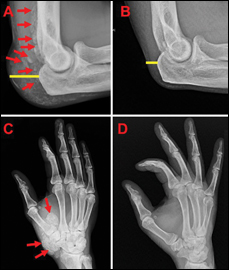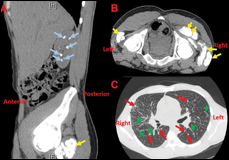Cola, sarcoid and soft-tissue calcification
A 43-year-old black man presented to his physician because of growing masses over his right elbow, hand and finger. He had noted an increase in polyuria and thirst and had been consuming 6 to 8 cups of cola drinks daily.
On exam, the soft-tissue masses were as large as 5 cm in size, firm and located in the soft tissue, not within the joints of the hands, hips, knees and elbows. He had a small mass biopsied from his right third fingertip that showed “calcinosis cutis.” The remainder of his physical exam was unremarkable.

Laboratory testing, imaging
Laboratory studies showed a creatinine level of 7.5 mg/dL (normal, 0.8-1.3 mg/dL), calcium 11.3 mg/dL (normal, 8.4-10.2 mg/dL), albumin 4 g/dL (normal, 3.5-4.8 g/dL), phosphorus 6.8 mg/dL (normal, 2.3- 3.7 mg/dL), 25-hydroxyvitamin D 30 ng/mL (normal, 30-100 ng/mL), 1,25-dihydroxyvitamin D 27 pg/mL (6-62 pg/mL), parathyroid hormone (PTH) 4 pg/mL (normal, 11-80 pg/mL), PTH-related protein less than 2 pmol/L (normal, < 4.7 pmol/L) and an elevated angiotensin-converting enzyme 104 U/L (normal, 9-67 U/L).

Images reprinted with permission from: Stephanie L. Lee, MD, PhD, ECNU.
Radiographs of the patient’s hand and elbow showed soft-tissue calcified masses (Figure 1). A CT scan without contrast of the chest, abdomen and pelvis showed many pulmonary nodules, renal calcinosis and heterotopic soft-tissue deposition of calcium next to his great trochanters (Figure 2). A transbronchial biopsy of the lung showed noncaseating granulomas, confirming the diagnosis of sarcoidosis.
The patient was started on a slow prednisone taper. Two days after starting the prednisone, his calcium level fell from 12 mg/dL to 10.8 mg/dL, and his 1,25-dihydroxyvitamin D fell from 27 pg/mL to 13 pg/mL. After prednisone therapy, cessation of cola intake and improved renal function, the soft-tissue masses clinically resolved in 4 months, and after 2 years the calcium deposits have resolved radiographically (Figure 1).
Identifying sarcoidosis
Sarcoidosis is a systemic disorder of unknown cause that is characterized by noncaseating granulomas with proliferation of epithelioid cells. Clinical signs and symptoms are nonspecific and include fatigue, general malaise and fever. Sarcoidosis is suspected based on symptoms and imaging studies. Diagnosis is confirmed by transbronchial lung biopsy or from extrapulmonary sites, such as the cervical lymph nodes and liver.
Pathologic findings of sarcoidosis include noncaseating granulomas with epithelioid cells and large, multinucleated giant cells. Laboratory data show that angiotensin-converting enzyme level is commonly elevated and may correlate with disease activity.

Sarcoidosis can be associated with hypercalcemia. Sarcoid granulomas ectopically secrete 1-hydroxylase enzyme that activates 25-(OH)D to the biologically active 1,25-dihydroxyvitamin D. The local excess production of 1,25-dihydroxyvitamin D increases intestinal absorption of dietary calcium to cause the hypercalcemia. Renal failure is a known risk of hypercalcemia and nephrocalcinosis in patients with sarcoidosis.
This patient’s renal failure, with the inability to efficiently excrete phosphorus, and the sarcoid-induced hypercalcemia and high phosphorus intake from colas led to elevated calcium and phosphorus levels. His calcium- phosphate product of 77 mg2/dL2 is greater than 65 mg2/dL2, which is the threshold that predicts an increased risk for calcium salt soft-tissue deposition.
The treatment of hypercalcemia from pulmonary sarcoid is prednisone 20 mg to 40 mg daily. The dose should be tapered as tolerated to 5 mg/day to 10 mg/day and continued for at least 12 months. This patient required 2 years of low-dose steroids before it was withdrawn. He currently is not taking prednisone and is eucalcemic.
- References:
- Demetrious ET, et al. J Bone Miner Res. 2010;doi:10.1002/jbmr.51.
- Hamzeh N. Med Clin North Am. 2011;doi:10.1016/j.mcna.2011.08.004.
- Iannuzzi MC, et al. N Engl J Med. 2007;357:2153-2165.
- For more information:
- Stephanie L. Lee, MD, PhD, ECNU, is an Endocrine Today Editorial Board member. She is associate professor of medicine and director of thyroid health in the Section of Endocrinology, Diabetes and Nutrition at Boston Medical Center. She can be reached at Boston Medical Center, 88 E. Newton St., Boston, MA 02118; email: stephanie.lee@bmc.org.
Disclosure: Lee reports no relevant financial disclosures.
